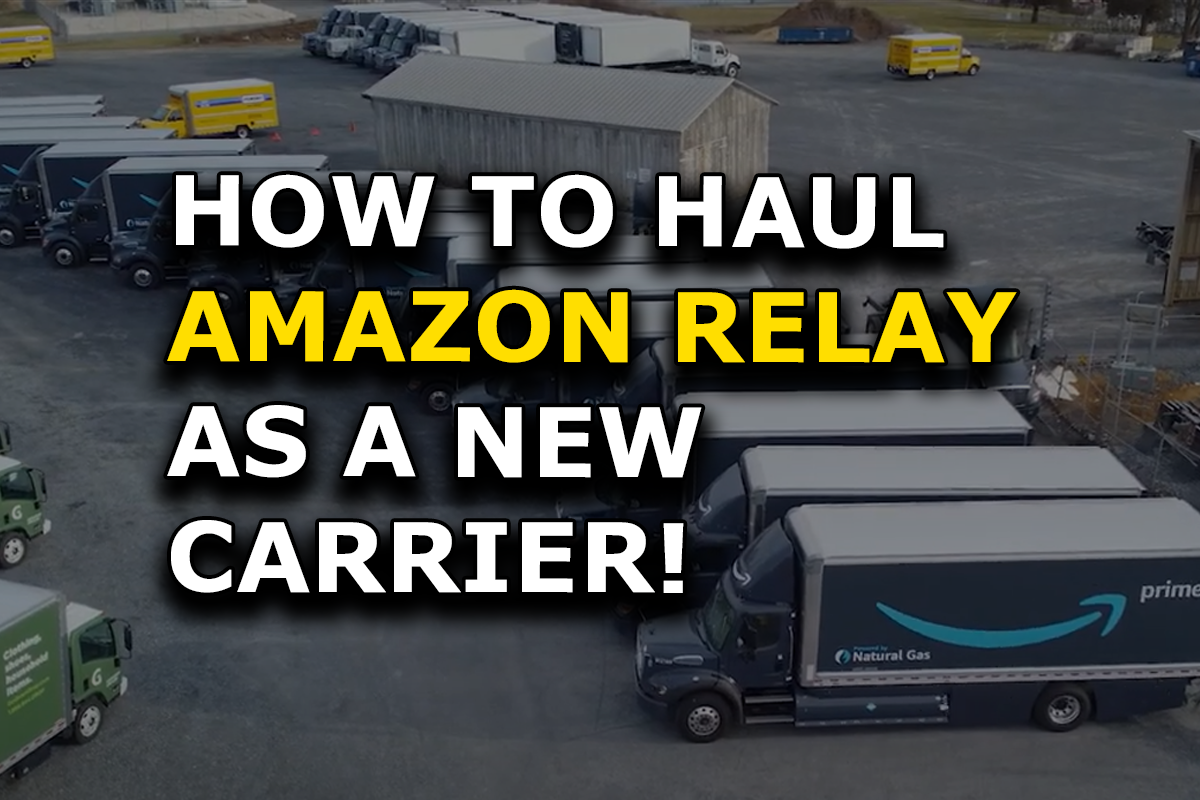Starting a business and want to haul for Amazon? Amazon Relay wants you to be in business for 6 months before driving for them.
If you’ve got the vision to start a trucking company and want to haul for Amazon (Relay) on day one, there are important requirements you need to know about!
You heard that right. New carriers cannot lease a box truck one day and start hauling for Amazon the next.
Their FAQ page states one of their requirements: You must have “a DOT number, with interstate authority and that has been active for minimum of 180 days, and a valid MC number.”
So, what can you do?
What do I do for the first 6 months?
The choices you make from this point forward greatly impact your startup cashflow, growth timeline, and large future payment dates.
Remember, expenses can be up to $20,000/month as a startup.
If you are planning to solely drive Amazon Relay freight, one option can save you thousands of dollars on insurance premiums.
Recommendation: Put your insurance policy on your personal vehicle for the first 6 months as you wait to haul for Amazon. Then switch to your commercial vehicle when you are ready.
Also, you need to know that new carriers, which have no safety history yet, can see more affordable insurance premiums if you declare to the insurance company on your application that you are going to operate within a 500-mile radius.
Then after some safe driving and history, you an slowly expand your distance if you want to driver long-haul cargo.
If you are committed to start as a long-haul trucking business, then expect to pay expensive insurance premiums for a couple years.
Recommendation: One of the easiest ways to save thousands of dollars in insurance premiums when you first start your trucking company is the geographical location of your business. In most cases, it is best to avoid major cities or areas susceptible to severe weather.
For example, trucking insurance is expensive in Atlanta, GA. However, a new carrier can save thousands of dollars if they just start the location of their business outside of the city. This includes your garaging address. In general, living in an urban area compared with a rural area can have a major impact on rates. In a metro area where there are more cars on the roads and more traffic, accidents are more likely, pushing rates higher.
If you plan to make changes to your garaging address, it is recommended that you notify your insurance company as soon as possible. Your insurer can make the necessary adjustments to your insurance policy to protect you against possible risks.
If you are committed to start as a long-haul trucking business, then expect to pay expensive insurance premiums for a couple years.
Do you have enough money saved right now?
The biggest reason owner-operators fail is not having enough money saved up before going on their own to manage start-up costs, maintenance emergencies, or lagging payments after finishing a load.
Truck drivers who are looking to go on their own must find a way to start a savings plan where you are regularly setting aside money, at least $200 per month. As you build your savings, you should learn how to build and use your credit score for when you later need to borrow for a truck purchase or repairs.
How much money do truckers need to save before becoming an owner-operator?
Starting your own business has a lot of expenses you should be prepared for, which includes:
- Paying taxes
- Start-up licensing and compliance costs
- Vehicle payments
- Vehicle maintenance
- Daily operating expenses (food, fuel, etc.)
- Commercial Truck Insurance
- and more
Recommendation: On average, truck expenses alone for a new owner-operator is usually around $15,000-$20,000 per month for a single truck. Before starting out, you should save up at least twice that to manage the first couple months of your new business.
Ideally, many consultants recommend saving for at least 6 months of operation, which is closer to $100,000.
This advice stems from the biggest issue after starting your new trucking business, dealing with your load payment terms.
Cashflow is the amount of money coming in versus coming out of the company. The issue for owner-operators at the beginning is not having money come in for at least 30 to 45 days after completing their first few loads.
Many trucking companies experience cash flow problems because they don’t charge enough per mile to cover their expenses. If you accept these super low rates, then the shipper assumes they can continue to get away with it. But you are the one moving the product, you are the professional, so make sure you know what your costs and worth are.
Recommendation: The most important thing for you to do for every load is determine your truck freight rate and cost per mile so you can cover your expenses and expected profit.
Just remember that these rates will fluctuate depending on your routes, if you are going in or leaving certain regions, and more.
- To calculate cost per mile, you need to examine your current expenses and forecast the number of miles you plan to drive this year. Then divide the expenses and profit by the miles.
- A truck freight rate is a price a shipper or broker will pay you to haul a load. While this sounds simple, these rates per mile can vary significantly depending on the time of year and current fuel prices.
- The most important number when it comes to calculating truck rates is the number of miles between your starting point and the destination.
- After distance, you need to know the weight of the shipment. To control costs, you must carefully manage the overall weight loading for your fleet. If you start with a higher rate for heavy loads, even if the shipper negotiates a discount, you will still end up with more total revenue.
- Lastly, is the shipment density so you know how much room a shipment will take up in your truck. Once you know the weight of the shipment, calculating the shipment density is simple. All you do is divide the cargo weight by its cubic feet.
What are the requirements to carry loads for Amazon Relay?
Amazon Relay enables carriers to tap into the Amazon load board network, technology, and safety-first culture to build and grow your fleet or Amazon owner operator businesses.
To join Amazon’s freight network, you must meet the following minimum requirements:
- A DOT number, with interstate authority and that has been active for minimum of 180 days, and a valid MC number
- “Carrier” entity type that is “Authorized for Property and for Hire”
- FMCSA Safety Rating of “Satisfactory,” “None,” or “Not Rated”
- Behavior Analysis and Safety Improvement Categories (BASIC) scores:
- Unsafe Driving below 60%
- HOS Compliance below 60%
- Vehicle Maintenance below 75%
- Controlled Substances / Alcohol below 75%
- Driver Fitness below 75%
- All required insurance policies including:
- Commercial General Liability not less than $1,000,000 per occurrence and $2,000,000 in the aggregate
- Auto Liability not less than $1,000,000 per occurrence, including a trailer replacement coverage of $50,000
- Cargo coverage of at least $100,000
- Workers’ compensation insurance in all jurisdictions where your company operates
- Employer liability not less than $100,000 per occurrence
Are you ready to start and need an insurance quote? We got you covered!
Fill out the information below and we can get a Amazon Relay insurance quick quote started for you.
If you have any questions or concerns, please email info@cnsinsures.com.






